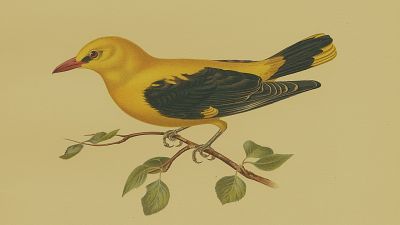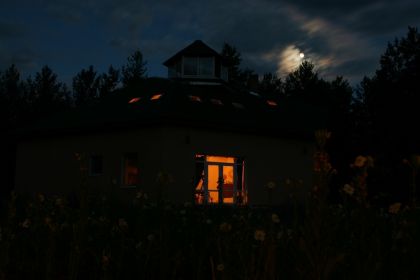Nature Sounds
Flute-like songs of golden oriole recorded in summer woods

Golden oriole
Country: Ukraine
Genre: Soundscapes
Of all the birds in the Northern hemisphere, the golden oriole has one of the most bewitching songs often reminiscent of a florid flute melody if it were played in a low register. This rather large bird with yellow and black plumage prefers to live in the crowns of tall trees and rarely appears in open spaces.
When moving through the treetops, a pair of golden orioles are most likely to either perform what sounds like a genuine flute duet with fanciful variations or simply communicate by using harsh calls that resemble yowls of a cat whose tail has been stepped on.
This review contains a transcript of the sounds recorded in June during daylight hours featuring songs and calls of golden orioles accompanied by other birds, insects, wind, and other sounds of nature. These soundscapes were recorded in the depths of a mixed forest where a set of microphones captured a stereo panorama. The captured soundscapes are that of a meadow with a diameter of about 100 meters that produces a multi-level echo and deep reverb. You can also download these nature sounds in HQ for free.
The recording session begins in the early hours, and a soft breeze can be heard moving the crowns of deciduous and coniferous trees in a sonic imitation of the sea surf, somewhat drowning out the bustle of morning birds. The golden oriole sings in the distance but its legato melody is clearly audible in the center of the stereo panorama and completely fills the background thanks to the layered echo of a forest meadow.
Listen to Golden oriole song accompanied by other birds:
Closer to noon, the chirping of grasshoppers and bush-crickets comes to the foreground of the soundscape, creating a truly meditative environment, especially with the recurring rustle of the wind. Shifting a little to the right, the golden oriole spreads its song through the meadow, now complemented by muted calls of other birds including thrushes, wagtails, and swallows.
Listen to Golden oriole song accompanied by insects and other birds:
By afternoon, the wind significantly picks up and completely masks all sounds produced by insects and birds, except for the loud communication between the pair of golden orioles still audible in the left channel. The couple alternates the scandalous call with their usual song performed in a higher register, and their voices gradually subside as the birds retire into the depths of the forest. Here you can also hear the creak of a tree swaying in the wind.
Listen to Golden orioles' talk accompanied by wind and other birds:
In the next soundscape, the golden oriole is localized in the left channel, while on the right you can hear the shrill call of the shrike and the distant song of another golden oriole. The wind, grasshoppers, and other birds also continue to harmonize.
Listen to Golden oriole song accompanied by wind:
For your relaxation, here is another extended soundscape from June of this year recorded in the afternoon. The recording features the sounds of birds and insects of the grassy meadow sheltered in a dense forest far from urban or industrial areas. On this hot summer day, the insects not once interrupted their song throughout the heatwave while the wind intensified and abated, revealing small details such as the small hammering sound in the left channel. This is the sound of a song thrush attempting to break the shell of a grape snail against the stone to eat the slug inside. Spans of swallows and insects sometimes interrupt the idyllic soundscape by moving right in front of the microphones. Golden orioles can also be heard moving closer from time to time.
Listen to Woodland sounds—bird calls, insects, and wind recorded on a summer morning:
All nature sounds on the MusicTales.club are recorded with professional equipment and available for free download in HQ. The soundscapes are processed with analog equipment and the maximum playback volume does not exceed their naturally-occurring volume levels, so you can listen to it without fear of hearing fatigue.



